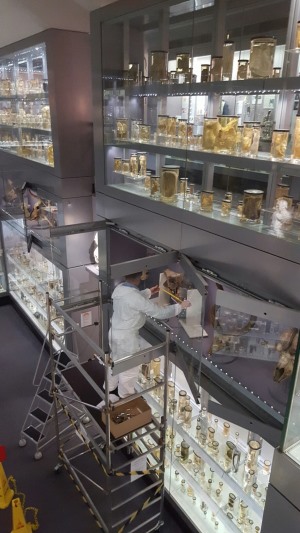Collections on the move: Our Skulls are Precious
09 Jun 2017
Susan Isaac

The skulls were mounted above the lower display cases in the Crystal Gallery, sitting on purpose built mounts within large front opening cases. A scaffolding platform was used to safely remove the skulls which are both heavy and bulky. In this video clip, Martyn Cooke, Head of Conservation Unit, can be seen moving the mandible of an elephant from the mount in the display case onto the scaffold platform. The platform is then lowered to the floor and the skull moved onto a hydraulic trolley to be transferred to the workroom. It’s important that, at every stage, the skull is supported in what is a precarious working space. This stage of the packing process was difficult but completed fairly quickly.
Once in the workroom, each skull is measured so that a customer-built crate can be made for it. The crates are wooden and made in such a way that the skull can be safely accessed by removing the top or any side of the crate. The wood is painted with an acrylic coating to seal it, stopping naturally occurring gases in the wood building up over the closure period and damaging the specimens.
The base of the crate is lined with Plastazote foam to cushion the skull. This material has been engineered to be both light and strong, making it particularly suitable for this type of work. Wooden supports and bracing are built and edged with more Plastazote foam to provide support for the skull, ensuring that it won’t move during transport. This is vital because, no matter how carefully the crates are moved, the vehicles used to transport them can still encounter speed bumps!

The crates will now be stored before being transported into temporary accommodation until we are ready to return to our Lincoln’s Inn Fields home. We will be posting more stories on the progress of this massive project - look out for the tagline “Collections on the move” and please get in touch if you have any questions or to leave us a comment.
You can find out more information on the future of the Lincoln’s Inn Fields building here. Or read “How to move an elephant” to learn about more of Hunter’s collection of specimens.
Susan Isaac, Information Services Manager



